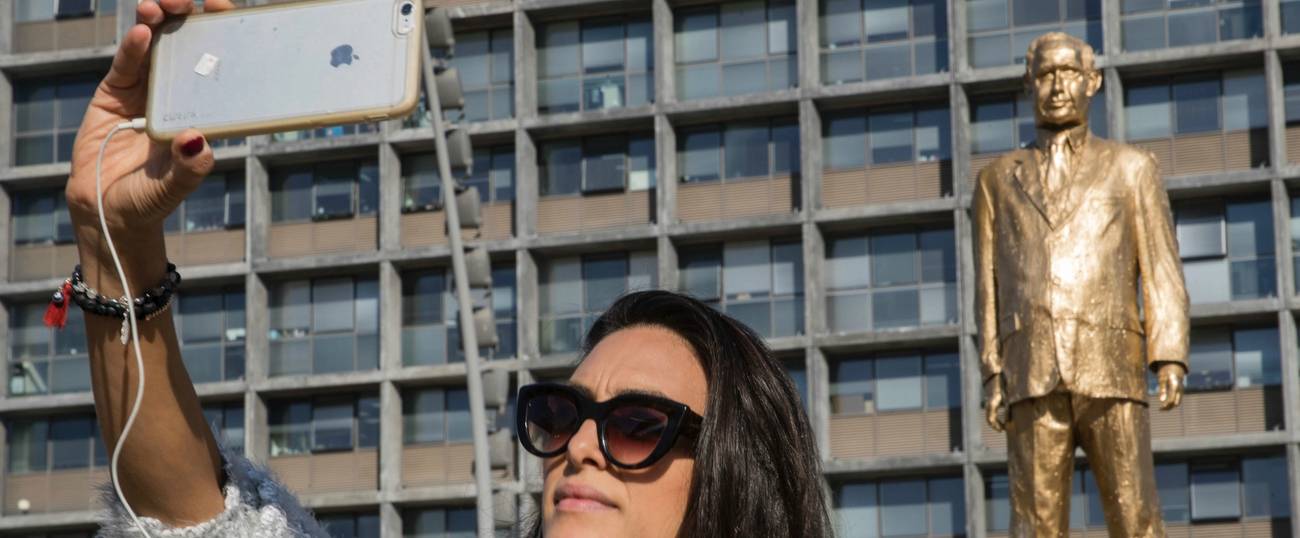Golden Bibi Effigy Pops Up in Rabin Square, Only To Be Torn Down
An Israeli guerrilla artist wowed Tel Avivians by erecting a golden statue of Benjamin Netanyahu on Monday, leading Israel’s left and right into public disagreement




For a moment on Tuesday, the political dream of the “Tel Aviv bubble”—a term used to describe the city’s residents as living in a different world from the rest of Israel—came true: It toppled Netanyahu.
Of course, the Netanyahu that Tel Aviv’s citizens brought down was not the Israeli Prime Minister himself; it was a gold-colored statue of his likeness perched on a pedestal behind red velvet ropes.
For hours, the person who put the effigy in the White City’s Rabin Square on Tuesday refused to identify himself, but was later revealed to be Israeli artist Itay Zalait.
Zalait, 37, was making a political statement, which he hoped would provoke public debate. He said he was inspired by social media comments admiringly calling the prime minister “King Bibi” (though he did not mention—and perhaps didn’t realize—that the title was first bestowed upon Netanyahu by TIME magazine in 2012.)
As for his motivation and message, Zalait asked The Jerusalem Post, “How does it feel to live in a country where a statue of the leader is in the center of the town? Right now, [my statue] feels like provocation, but it could become reality.”
The Tel Aviv municipality ordered that the statue be removed in the early afternoon, as it was put up without a permit. However, before this could occur, onlookers pulled it down in a chaotic scene captured on video and in pictures, which were shared across social media. One photo of a woman’s boot on Netanyahu’s golden head that went viral.
As with anything else in Israeli politics, the response to the statue was mixed. So were the metaphors it evoked, ranging from the biblical Golden Calf to Saddam Hussein.
On the Left, for the most part, it seemed that people saw the statue as the artist intended: a clever way to say that Netanyahu is like a third-world dictator.
The display came at a tense time for the “Tel Aviv bubble,” which is, stereotypically, left-wing and Ashkenazi. The derogatory term, which inspired the name of a popular movie a decade ago, evokes detachment and elitism among the media, artists and otherwise bohemian folks that live and work in the city. The bubble-dwellers, who have never been big fans of Netanyahu, have just about had it with him.
In recent weeks, as several investigative reports have landed Netanyahu in hot water—publicly, if not legally—his office has posted on Facebook and released to the media a series of ad hominem responses attacking prominent journalists’ records and saying the media has a vendetta against him. (Unsurprisingly, comparisons between Bibi and Trump have been made, though Netanyahu’s twitter account is carefully curated.) Much of said media has responded to the statements by saying that Netanyahu seeks to censor them, to which the Prime Minister responded in the Knesset this week saying the free speech they enjoy includes his right to criticize.
The art world has also been shaken by government policies, though not by Netanyahu directly. Culture Minister Miri Regev has threatened to pull funding from cultural institutions displaying works that support or glorify terrorism, and those that refuse to perform in the West Bank. In response, artists have called her a fascist, organized protests, and jeered when she has attended various award ceremonies.
The right-wing response to the statue can be mostly summed up by Regev’s Facebook post on the matter: “How disconnected from reality can an artist be! Israel is a democracy [with] individual rights, civil rights, moral sensitivity, an activist judiciary, free media, and, in short, one of the super-free countries. But [this is] disconnected art, and its Golden Calf is hatred of Netanyahu.”
Tel Aviv Deputy Mayor Arnon Giladi, also of Likud, called the statue a “cheap provocation” that showed the Left does not accept the results of a democratic vote. “The same artists always make sure to speak loftily about freedom of expression, but only when it concerns a political position they support,” Giladi told Ma’ariv.
As amusing as Tuesday’s news cycle was, with all its focus on the statue as if nothing else important was happening in the country, it just served to highlight the rancorous political atmosphere in Israel. And there are lessons here for both sides of the partisan divide.
“The majority may want Netanyahu as prime minister,” journalist-cum-transparency-crusader Tomer Avital wrote on Facebook, “but the other part [of the population] despises him at almost unprecedented levels. I hope Netanyahu will come to understand already that this is a bad thing. That he will remember we are one nation and change direction.”
Meanwhile, the “Tel Aviv bubble” has to work on itself, as well. Hatred is not, or at least should not, be a political platform. It needs to wake up, engage in a bit of introspection in order to decide how to best engage with the public, and try convince the rest of the country if it wants to win in the ballot booth and not just in guerrilla art.
Lahav Harkov is the diplomatic correspondent for The Jerusalem Post. She tweets at @LahavHarkov.